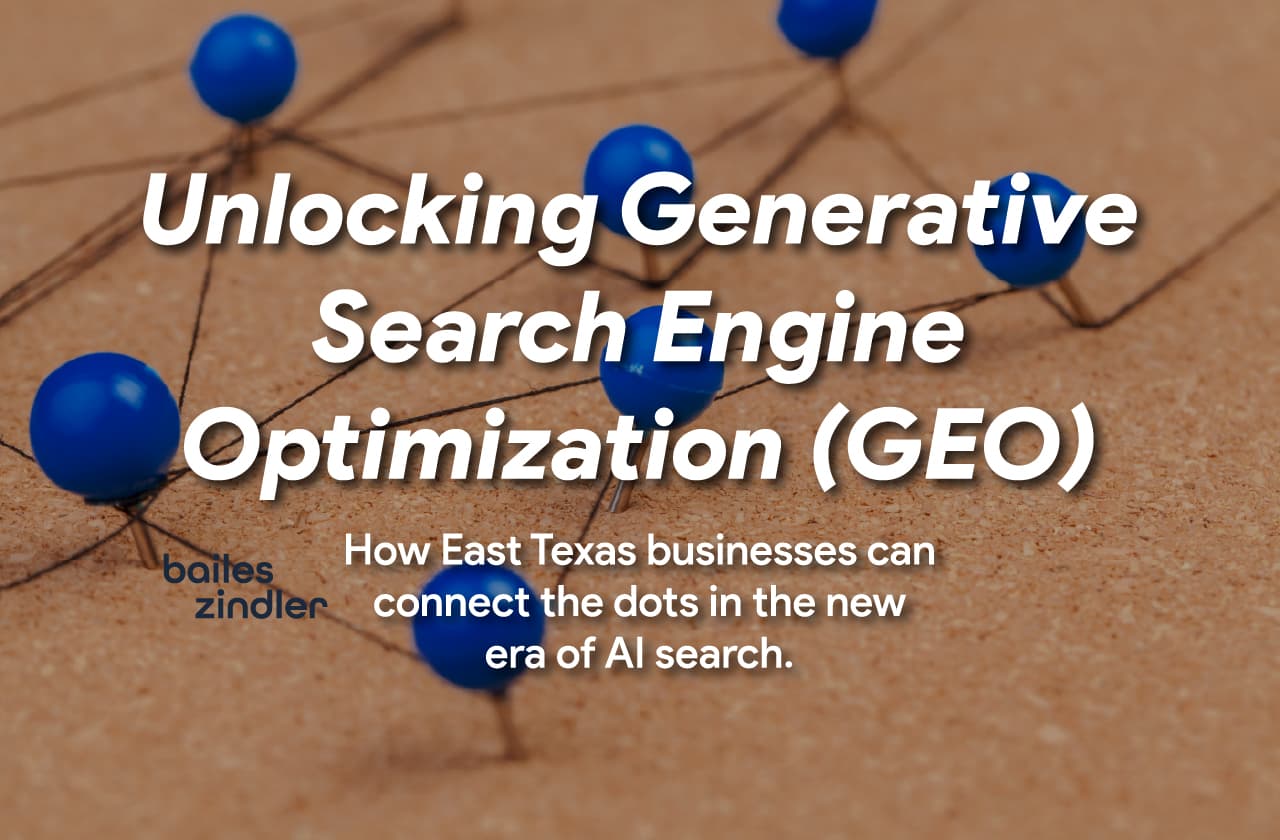Listen: TLDR Audio Description (3:05)
The search revolution is already happening, it just stopped looking like a search bar.
If 2024 was the year AI Overviews changed Google forever, 2026 is the year Generative Engine Optimization (GEO) changes how businesses get discovered.
Search is no longer a list of links. It is a conversation between people and algorithms. And for East Texas businesses, that means adapting before your competitors realize the rules have changed.
What GEO (or AEO) Really Means
Generative Engine Optimization, sometimes called Answer Engine Optimization (AEO), is part of a broader discipline known as AI Search Optimization. It focuses on making your business understandable to machines that generate answers.
The goal is not just to rank higher, but to be cited, summarized, and recommended by AI models inside tools like ChatGPT, Gemini, Perplexity, Bing Copilot, and Apple Intelligence.
Traditional SEO asked: How do I rank higher on Google?
GEO asks: How do I get my brand woven into the answers AI systems give to real people?
According to research from Andreessen Horowitz and Search Engine Journal, including citations, statistics, and clear entities can increase your chance of being cited by AI models by more than 40 percent. The foundation is not keyword stuffing, it is structured clarity.
Why East Texas Businesses Should Care Now
Every Tyler law firm, Bullard restaurant, and Lindale home services company has built marketing around visibility: the right keywords, reviews, and map pins.
But in 2026, visibility is no longer about appearing first. It is about appearing correctly inside an AI’s reasoning chain.
Generative engines do not scroll your homepage, they read your schema.
They do not skim reviews, they summarize sentiment.
They do not click, they cite.
That means a law firm in Tyler with FAQ-rich criminal defense pages might be quoted directly by Copilot in a “What should I do after a DWI arrest?” query, even if the user never opens a browser.
Or a restaurant in Lindale that publishes JSON-LD menu data could appear in Gemini’s “best farm-to-table spots near me” answer without needing an ad budget.
If you have already read our What Is AI SEO? guide, you know this shift is part of a much larger movement toward zero-click search results and conversational engines.
Local search used to reward whoever shouted the loudest. GEO rewards whoever speaks the clearest.
Key GEO Tactics for 2026
1. Conversational Intent Optimization
Write the way your customers talk and the way AI interprets. Use natural phrases such as “best family restaurant in Tyler” or “how much does an East Texas lawyer charge for” to match real conversational search flows.
AI systems reward natural, intent-driven phrasing over rigid keyword repetition. This aligns directly with Voice Search Optimization (VSO), where queries are spoken aloud rather than typed.
2. Structured Data and llms.txt
Implement rich JSON-LD for every product, service, or FAQ.
Add llms.txt and llms-full.txt to your site root to guide AI crawlers like GPTBot, PerplexityBot, and ClaudeBot. These files tell AI systems which content is available for training or citation, forming the next step in SEO governance.
3. Entity Building Through Brand Mentions
AI visibility correlates with how often your business is mentioned, not just linked.
A 2025 XFunnel study found third-party citations are the most common AI source type. Build your entity footprint by keeping your Name, Address, and Phone number consistent across Google Business, Yelp, and local directories. Earn mentions on reputable local and industry sites.
4. Omnichannel Presence Across Voice, Video, and Chat
Every medium is now a data source. A YouTube video transcript, a podcast Q&A, or a Google Business Q&A answer can train or inform AI systems.
Publish across multiple channels. Each one is a new path for AI to understand and surface your expertise.
If you are optimizing across multiple AI-driven surfaces, consider reading Zero-Click Search Exposure, which explains how to gain visibility when clicks are no longer guaranteed.
East Texas GEO in Action
Law Firm (Tyler)
Add Service schema for DWI Defense, publish legal FAQs, and sync your citations.
When someone asks Perplexity “Who is the top criminal defense lawyer in Tyler?”, your firm becomes part of the dataset.
Restaurant (Bullard)
Use Menu schema, add detailed alt text for dishes such as “Wood-Grilled Ribeye at The Grove Tyler,” and allow AI crawlers to access your site.
Gemini may include your restaurant in “top East Texas dining spots” summaries.
Home Services (Lindale and Whitehouse)
Add Service schema for HVAC Repair and Roof Inspection. Maintain updated Q&A content.
When a user asks Copilot “Who fixes AC units in Whitehouse?”, your company can appear directly in the generated answer.
The GEO Checklist: How to Get Started
✅ Add and verify structured data for every service page
✅ Create llms.txt and llms-full.txt to manage AI crawler access
✅ Use entity-rich copy with consistent NAP information
✅ Publish FAQ sections in conversational language
✅ Maintain accurate local listings across directories
✅ Add transcripts or captions to all videos and podcasts
✅ Track AI citations and mentions monthly using tools such as Dark Visitors
For more implementation detail, explore the AI Search Optimization overview on our Capabilities page.
The Takeaway
Generative Engine Optimization is not about gaming algorithms. It is about clarity, structure, and trust. When machines understand what you do, humans discover you faster.
The next generation of search is already learning how to talk about East Texas. Make sure it knows how to talk about you.
References
How Generative Engine Optimization (GEO) Rewrites the Rules of Search (a16z)
Structured Data’s Role in AI and AI Search Visibility (Search Engine Journal)
Explore AI Search Optimization Services
or Schedule a GEO Audit

